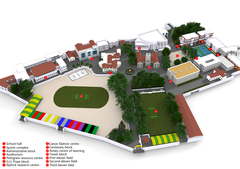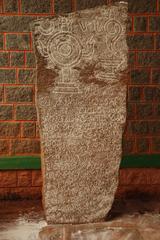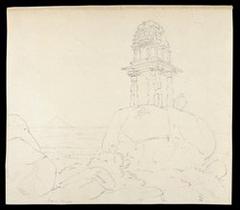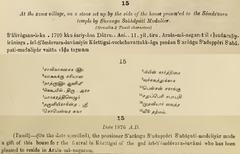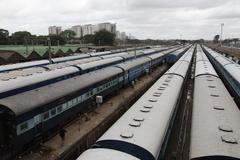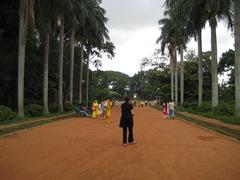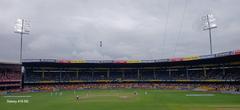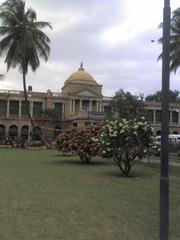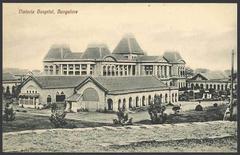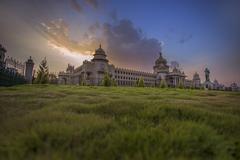Laboratory for Electro-Optics Systems (LEOS) Bengaluru: Visiting Hours, Tickets, and Visitor Information
Date: 04/07/2025
Introduction
The Laboratory for Electro-Optics Systems (LEOS), located in Bengaluru, India, is a premier research facility under the Indian Space Research Organisation (ISRO). Since its establishment in 1993 at the historic Peenya Industrial Estate—where India’s first satellite Aryabhata was fabricated—LEOS has played a pivotal role in the nation’s space program. It specializes in developing advanced electro-optical sensors and systems essential for spacecraft attitude control, navigation, and scientific payloads. LEOS’s technological innovations have been integral to major missions, such as Chandrayaan-1 and Chandrayaan-3, including the development of the Laser-Induced Breakdown Spectroscopy (LIBS) instrument used for the first in-situ detection of sulphur on the Moon (Wikipedia; Spectroscopy Online).
Though LEOS itself is a high-security research facility with restricted public access, its achievements are frequently showcased at science museums and public ISRO events in Bengaluru. Institutions such as the Visvesvaraya Industrial and Technological Museum and the Jawaharlal Nehru Planetarium feature exhibits that highlight LEOS’s contributions to India’s space program (ISRO; URSC). For academic and professional groups, guided visits may be possible through official ISRO channels, subject to strict security protocols.
This guide provides a comprehensive overview of LEOS’s history, technological significance, visitor access requirements, nearby attractions, and practical travel tips for anyone interested in exploring Bengaluru’s vibrant scientific landscape.
Contents
- Overview and Historical Significance
- Evolution and Technological Milestones
- Core Technologies and Innovations
- LEOS’s Role in India’s Space Program
- Visitor Access and Guidelines
- Practical Travel Tips
- Frequently Asked Questions (FAQ)
- Suggested Science Itinerary
- Conclusion and Resources
LEOS: Historical Background and Technological Milestones
Origins and Establishment
LEOS was founded in 1993 at Peenya Industrial Estate, Bengaluru, consolidating India’s efforts in electro-optic systems crucial for space missions (Wikipedia; ISRO). Its location in Bengaluru leverages the city’s robust technology and aerospace ecosystem, facilitating the recruitment of top talent and access to advanced manufacturing infrastructure.
Technological Evolution
Early Contributions (1990s–2000s)
LEOS’s early work centered on developing attitude sensors and optical systems for several landmark satellites, including Aryabhata, Bhaskara, APPLE, IRS, SROSS, and the INSAT-2 series. The lab pioneered indigenous technologies such as star trackers, sun sensors, and gyroscopes, laying the foundation for India’s growing space ambitions (URSC).
Advanced Innovations (2000s–Present)
With ISRO’s expanding mission scope, LEOS has advanced into designing 3-axis fiber optic gyroscopes, MEMS devices, and optical communication terminals. The lab has also delivered sophisticated instrumentation for space astronomy and planetary science missions, such as the Ultra Violet Imaging Telescope (UVIT) and large lightweight telescope mirrors (ISRO; URSC).
Core Technologies and Scientific Payloads
- Attitude Sensors: Including star trackers, sun sensors, and gyroscopes, vital for spacecraft stabilization and navigation.
- Optical Systems: Development of refractive/reflective optics, large mirrors, and advanced coatings to enhance performance in space.
- Science Payloads: Instruments like the Lunar Laser Range Instrument (LLRI) and LIBS for lunar exploration, as well as payloads for solar missions (Aditya-L1) and space telescopes (UVIT, VELC).
- Indigenous Innovation: LEOS has led the development of silicon photodetectors, MEMS inclinometers, and UV detectors, reinforcing India’s technological self-reliance (URSC).
LEOS’s Role in ISRO and Indian Space Research
LEOS underpins ISRO’s deployment of satellites for communications, remote sensing, disaster management, and scientific exploration. Its indigenous technologies have reduced foreign dependency and raised India’s profile in global space research (ISRO). The laboratory actively collaborates with both public and private sector partners, fostering innovation across the Indian aerospace ecosystem.
Visitor Access: Hours, Tickets, and Protocols
Can You Visit LEOS?
- General Public: LEOS is not open for casual tourism due to its sensitive research and security protocols.
- Academic and Professional Groups: Educational institutions, industry experts, and official delegations may apply for guided visits via formal requests to ISRO’s outreach offices. Applications require advance notice (4–6 weeks), security clearances, and must specify the purpose and number of visitors.
Visiting Hours
- Scheduled Visits: Visits are typically scheduled during regular weekday working hours. Exact timings are communicated upon confirmation.
- Documentation: All visitors must provide valid government-issued ID. Foreign nationals require extra clearances.
Tickets and Fees
- LEOS Facility: No public ticket sales; access is granted only by invitation or special arrangement.
- Science Museums: Exhibits featuring LEOS technologies are available in science museums, with entry fees ranging from free to nominal rates.
On-Site Conduct
- Arrival: Arrive early to complete security checks and registration.
- Accompaniment: Visitors are escorted at all times and may only access designated areas.
- Prohibitions: Photography, videography, and use of electronic devices are strictly forbidden inside the facility.
Safety and Health Protocols
- COVID-19: Health screenings, masks, and sanitization protocols are enforced as per current advisories (July 2025).
Practical Travel Tips for Science Tourists
How to Reach LEOS
- Location: Peenya Industrial Estate, Bengaluru, Karnataka.
- Transport: Bengaluru City Railway Station and Kempegowda International Airport are the nearest major transit points. Use private transport or ride-hailing services for convenience.
Nearby Science and Cultural Attractions
- Visvesvaraya Industrial and Technological Museum: Interactive engineering and space exhibits (TravelTriangle).
- Jawaharlal Nehru Planetarium: Astronomy shows and hands-on science education.
- Indian Institute of Science (IISc): Occasional public lectures and science festivals.
- Cubbon Park and Bangalore Palace: For a blend of culture and leisure (IndianEagle).
Best Time to Visit
- September to February: Pleasant weather and major science events (IndiaTourism).
Accessibility
- Special Arrangements: Inform ISRO in advance regarding mobility or accessibility needs.
Frequently Asked Questions (FAQ)
Q: Can I visit LEOS as a tourist?
A: No, only approved academic or professional groups are allowed.
Q: How do I arrange a visit?
A: Submit a formal request through your institution to ISRO’s public outreach office.
Q: Are there tickets for LEOS?
A: No public tickets are available; access is by invitation only.
Q: Where can I learn about LEOS’s work if I can’t visit?
A: Explore ISRO exhibitions and museums in Bengaluru, which often display LEOS-developed technologies.
Q: When are science museums in Bengaluru open?
A: Typically 10:00 AM–5:30 PM, except Mondays.
Suggested Science and Culture Itinerary
Day 1: Visvesvaraya Industrial and Technological Museum, Cubbon Park
Day 2: Jawaharlal Nehru Planetarium, IISc public lecture
Day 3: (If arranged) Guided LEOS visit, followed by city heritage walk
Day 4: Explore Bangalore Palace and local science parks
Conclusion
LEOS represents the pinnacle of India’s indigenous space sensor development, contributing to the success of over 100 satellites and major interplanetary missions. While direct public access is limited, the impact and innovation fostered at LEOS are accessible through exhibitions, museums, and the broader scientific culture of Bengaluru. By following official protocols and planning your itinerary around the city’s vibrant science and cultural attractions, you can experience the spirit of India’s space achievements.
For the latest updates on events, tours, and science news, consult the ISRO Official Website and stay connected through recommended resources.
Sources and External Links
- Laboratory for Electro-Optics Systems (LEOS), Indian Space Research Organisation
- Laboratory for Electro-Optics Systems - Wikipedia
- New Discoveries from India’s Chandrayaan-3 Rover at the Lunar South Pole Using LIBS and APXS Spectroscopy, Spectroscopy Online
- About LEOS, U R Rao Satellite Centre (URSC)
- TravelTriangle: Places to Visit in Bangalore
- IndianEagle: Bengaluru Travel Guide
- IndiaTourism: Bangalore Itinerary

